Procedures: Placement
Immediate Function
Immediately after the placement of the implant, a transitional tooth is inserted into the implant, which not only stabilizes the implant but also provides the patient with a functioning tooth during the 3 to 4 months of healing.
- Functioning transitional teeth after patient's first appointment.
- Treatment may be completed in only 3 visits.
- Implant placement to final restoration possible in 3 to 4 months.
- Patient is never without a fixed tooth.
 |
 |
 |
 |
|||
| Radiograph of upper jaw without teeth before placement of eight Bicon implants. |
Transitional functioning teeth immediately after implant placement. |
Radiograph of functioning transitional teeth and eight Bicon implants. |
Final restoration with Bicon Integrated Abutment Crowns™. |
One-Stage
After the extraction of the tooth and subsequent implant placement, a healing abutment is inserted into the implant to facilitate the formation of a soft tissue sulcus around the implant.
- Healing abutment facilitates formation of soft tissue sulcus.
- Eliminates need for a second surgical procedure to uncover implant.
- Implant placement to final restoration possible in 3 to 4 months.
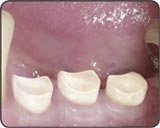 |
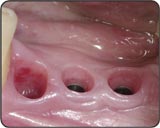 |
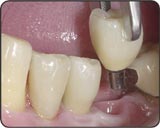 |
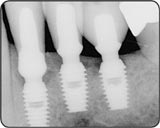 |
|||
| Three healing abutments seated in their Bicon implants. |
Implant wells and sulci after the removal of the plastic healing abutments. |
Bicon Integrated Abutment Crown™ (IAC) being seated in Bicon implant. |
Radiograph of three cementless and screwless IACs in Bicon implants. |
Two-Stage
After the implant is placed, it is covered by the gum tissue throughout the healing process. After a period of healing, the implant is surgically uncovered for the insertion of an abutment.
- Implant is covered by the gum tissue throughout the healing process.
- Implant is uncovered at a second surgical visit.
- Implant placement to final restoration possible in 3 to 4 months.
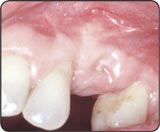 |
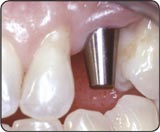 |
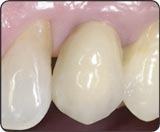 |
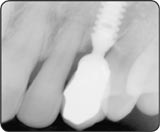 |
|||
| Bicon implant is in the bone beneath the gum tissue during the healing period. |
After healing, an opening was made for the insertion of a Bicon abutment. |
Porcelain fused to metal (PFM) crown cemented onto the Bicon abutment. |
Radiograph of final restoration. |
Procedures: Restoration
Fixed Prosthetics
Individual Teeth: Bicon implants can be restored by intra-orally or extra-orally cementing porcelain fused to metal (PFM) crowns or all-ceramic crowns to their abutments. Alternatively, they may be restored with the cementless and screwless Bicon Integrated Abutment Crowns™ (IAC).
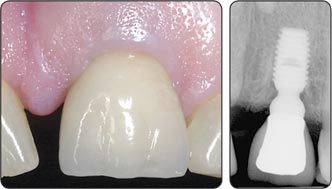 |
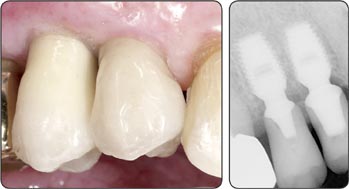 |
|
| Porcelain Fused to Metal Crowns: View of a PFM crown on a Bicon implant. Radiograph shows porcelain fused to metal (PFM) crown and Bicon implant. |
All-Ceramic Crowns: Two all-ceramic crowns on Bicon implants. Radiograph shows two all-ceramic crowns and Bicon implants. |
 |
| Bicon Integrated Abutment Crowns™: First picture shows ten IACs ready to be inserted. Second picture shows one IAC being inserted into the Bicon implant. Top right shows full complement of individual aesthetic restorations with IACs. Radiograph shows thirteen Bicon Integrated Abutment Crowns™ and Bicon Implants. |
Removable Prosthetics
| Implant-Retained Denture: Rubber o-ring attachments provide for snap-on retention over implant abutments for a soft tissue borne removable denture. |
Implant-Supported Denture: Either telescopic sleeve abutments or a screw-retained bar prosthesis provide for a frictionally retained and implant-supported removable denture. |
|
 |
 |
|
| View of an upper arch with four Bicon o-ring abutments on Bicon implants. Palateless denture snapped onto four Bicon o-ring abutments. |
View of upper arch with eight Bicon milled telescopic sleeve abutments on Bicon implants. Palatal view of a Bicon implant-supported telescopic sleeve denture. |